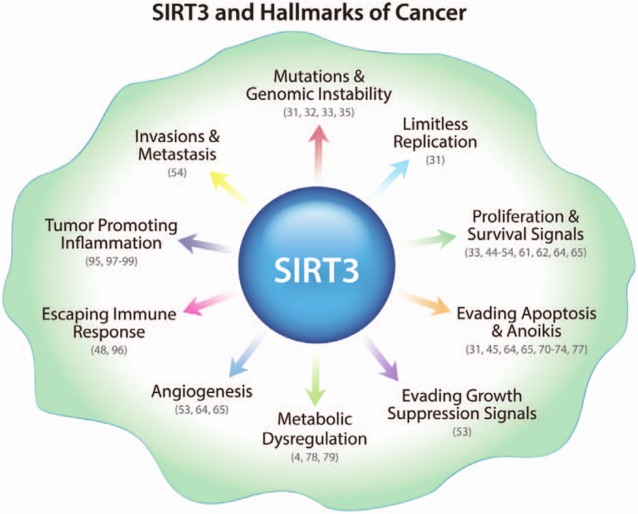Figure 1.
Mutations and genomic instability: Genomic instability and mutations may result in the amplification of oncogenes or inactivation of tumor suppressors, which drive tumor progression. SIRT3 promotes mutagenesis and increases genomic stability through ROS and deacetylation of H4K16ac and H3K9ac.31-33,35 Limitless replication: Normal cells have a limited life span, whereas cancer cells possess infinite replicative potential, also called cell immortalization. SIRT3 is involved in the immortalization process in the presence of Myc or Ras.31 Proliferation and survival signals: Cancer cells become self-sufficient in growth signals and therefore acquire uncontrolled proliferative capacity. SIRT3 plays a role in proliferative and survival signaling pathways in normal and cancer cells (tumor promoter) via maintaining ROS thresholds, activation of a FOXO3-dependent antioxidant mechanism and NF-κB, and its modulation through MAPK/ERK, PI3K/Akt, and AMP kinase pathways.33,44-54,61,62,64,65 Evading apoptosis and anoikis: Apoptosis, a form of programmed cell death, is a genetically regulated cell-suicidal mechanism involved in the regulation of normal tissue homeostasis. However, cancer cells are able to bypass this mechanism. In addition to regulating cell proliferation and survival, SIRT3 plays a proapoptotic role (tumor suppressor) in normal and cancer cell types.31,64,65,70-74,77 Anoikis resistance or anchorage-independent growth contributes to cancer development and progression. SIRT3 plays a role in mediating anoikis resistance and tumorigenesis.45 Evading growth suppression signals: Cancer cells negatively regulate cell proliferation, and many of these programs depend on the actions of tumor suppressor genes. p53-induced growth arrest is regulated by the mitochondrial SIRT3 deacetylase.53 Metabolic dysregulation: Cancer cells have developed the ability to reprogram their cellular metabolism to sustain growth and tumor progression. SIRT3 modulates cellular metabolism, the Warburg effect, and tumorigenesis.4,78,79 Angiogenesis: To sustain the growth of tumors, cancer cells chronically activate angiogenesis and an unbalanced mix of proangiogenic signals. SIRT3 is indirectly associated with angiogenesis through HIF-1α and p53.53,64,65 Escaping immune response: Cancer cells acquire the ability to evade immunological destruction, especially by T and B lymphocytes, macrophages, and natural killer cells. SIRT3 is involved in inflammation and autoimmune dysfunction through activation of the renin-angiotensin system.48,96 Tumor-promoting inflammation: Innate immune cells, which are designed to fight infections and heal wounds, inadvertently support these cancer hallmarks, thereby leading to tumor promotion. SIRT3 is involved in proinflammatory responses through the modulation of ROS.95,97-99 Invasion and metastasis: Cancer cells invade local tissue, spread to distant sites, and develop new tumors at secondary sites. Increased levels of SIRT3 transcription are associated with lymph node metastasis in breast cancer.54

